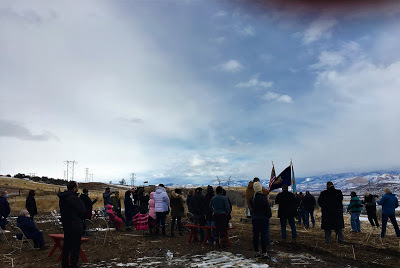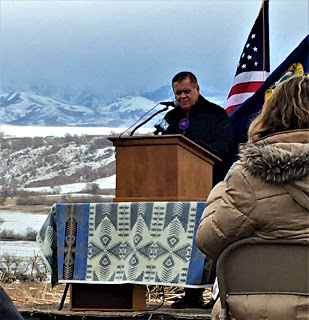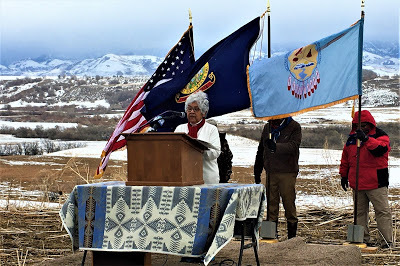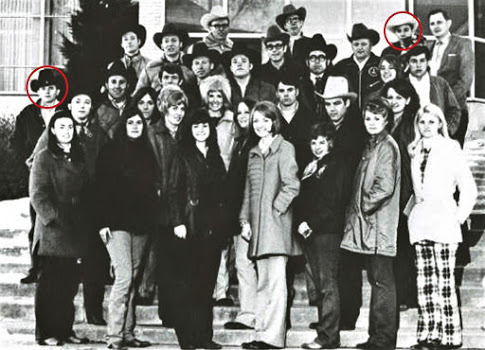Rod Miller's Blog, page 11
March 15, 2021
Where I was 47 years ago.
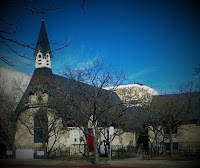
March 15, 1974. Ogden, Utah. Church of the Good Shepherd. Getting married for the first and (almost) last time.
March 5, 2021
History gone wrong: Forgetting Dominguez.
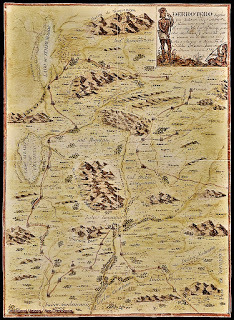 The name “Escalante” graces many places on the map of Utah. There’s a town, a basin, a canyon, a desert, a mountain, a natural bridge, a river, a state park, and—in partnership with Grand Staircase—a national monument. Maybe more.
The name “Escalante” graces many places on the map of Utah. There’s a town, a basin, a canyon, a desert, a mountain, a natural bridge, a river, a state park, and—in partnership with Grand Staircase—a national monument. Maybe more.If you’re unfamiliar with the history of my home state you may wonder why this is. And there are some of us familiar with that history who also wonder why.
Our story begins in 1776, when folks Back East were quibbling with Great Britain. Out here in New Spain, later to be part of Mexico, and later still becoming much of the western United States, the Spaniards had already established missions and settlements, and were exploring trade routes and sites for other missions.
Enter Fray Francisco Silvestre Vélez de Escalante. Or, as we in Utah’s schools call him, Father Escalante. The good Father was with an expedition seeking a route from Santa Fe to Monterey. Their path brought them into what is now Utah—through the Unita Basin and the Wasatch Mountains and Utah Valley, then deep into the southern part of our state.
The way Escalante’s name got plastered all over the place, you’d think he was in charge of the whole thing. But that’s where history (the popular notion of history, that is) gets it wrong.
In truth, Escalante, who kept the diary of the expedition, and Bernardo de Miera y Pacheco, the mapmaker (see his handiwork above), and the handful of other men in the party were under the command of Fray Francisco Atanasio .
organized the journey. Domínguez led the way. Domínguez determined the route. Domínguez gave the orders. Domínguez made the tough decisions.
His name does not appear on any prominent place or landmark on the maps of Utah.
February 23, 2021
A Thousand Dead Horses hit the trail.
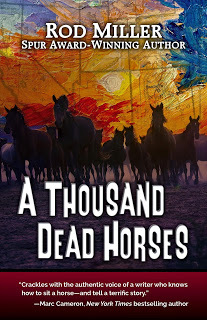
After being bedridden for six months because of the coronavirus pandemic, A Thousand Dead Horses is finally on the market.
By happenstance, like Pinebox Collins, the novel that precedes it, it features a main character with a wooden leg. But I had no choice this time. The book is based on a historic horse-stealing expedition from the 1840s, and one of the primary perpetrators of that adventure was famed mountain man Thomas L. “Pegleg” Smith. Honest.
Besides Pegleg Smith, the story features other characters from history including mountain men “Old Bill” Williams and James Beckwourth, and Ute leader Wakara. The horses and mules they stole are real, too—but I don’t know their names.
Marc Cameron, New York Times bestselling author of the Jericho Quinn political thrillers, the Arliss Cutter crime novels, and several of the Tom Clancy Jack Ryan novels, says, “A Thousand Dead Horses crackles with the authentic voice of a writer who knows how to sit a horse—and tell a terrific story. Fire embers snap, saddle leather groans—and the richly drawn characters pull you along with them on their adventure.”
The story, based on history from the Old West, will take you from Santa Fe to California and back again on the Old Spanish Trail.
Ride along.
February 13, 2021
My Favorite Book, Part 25.
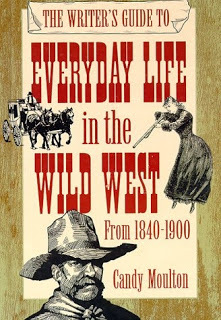
The Writer’s Guide to Everyday Life in the Wild West, from 1840-1900 by Candy Moulton is not the kind of book where you start at the beginning and keep turning pages until you reach the end. Not at all. It is a reference work; as the title indicates, a guide for writers.
But don’t let that discourage you. While I do use it for reference in my writing, and have done so for years, I also read the book for enjoyment. From time to time I will lift it off the shelf where it lives beside my desk and open it at random. No matter where I land, I will find interesting facts about how folks used to live, whether at home or at work or on the trail.
Where else would you learn, for instance, that Doc Holliday charged three dollars to pull a tooth? Or the ins-and-outs of two-story outhouses? Or that it took 700 pounds of bacon to get a family of four across the plains? Or the use of “Nebraska Marble” in home construction?
Every page is peppered with tidbits of the sort—information that is engaging to contemplate, interesting to learn, and fun to know.
So, whether you are a writer or not, this is a book you should own. After all, who knows when an occasion may arise over dinner or drinks to point out that the song “Dinah Had a Wooden Leg” was a big hit among cowboys in the Wild West.
My Favorite Book, Part 22.

The Writer’s Guide to Everyday Life in the Wild West, from 1840-1900 by Candy Moulton is not the kind of book where you start at the beginning and keep turning pages until you reach the end. Not at all. It is a reference work; as the title indicates, a guide for writers.
But don’t let that discourage you. While I do use it for reference in my writing, and have done so for years, I also read the book for enjoyment. From time to time I will lift it off the shelf where it lives beside my desk and open it at random. No matter where I land, I will find interesting facts about how folks used to live, whether at home or at work or on the trail.
Where else would you learn, for instance, that Doc Holliday charged three dollars to pull a tooth? Or the ins-and-outs of two-story outhouses? Or that it took 700 pounds of bacon to get a family of four across the plains? Or the use of “Nebraska Marble” in home construction?
Every page is peppered with tidbits of the sort—information that is engaging to contemplate, interesting to learn, and fun to know.
So, whether you are a writer or not, this is a book you should own. After all, who knows when an occasion may arise over dinner or drinks to point out that the song “Dinah Had a Wooden Leg” was a big hit among cowboys in the Wild West.
The Writer’s Guide to Everyday Life in the Wild Wes...

The Writer’s Guide to Everyday Life in the Wild West, from 1840-1900 by Candy Moulton is not the kind of book where you start at the beginning and keep turning pages until you reach the end. Not at all. It is a reference work; as the title indicates, a guide for writers.
But don’t let that discourage you. While I do use it for reference in my writing, and have done so for years, I also read the book for enjoyment. From time to time I will lift it off the shelf where it lives beside my desk and open it at random. No matter where I land, I will find interesting facts about how folks used to live, whether at home or at work or on the trail.
Where else would you learn, for instance, that Doc Holliday charged three dollars to pull a tooth? Or the ins-and-outs of two-story outhouses? Or that it took 700 pounds of bacon to get a family of four across the plains? Or the use of “Nebraska Marble” in home construction?
Every page is peppered with tidbits of the sort—information that is engaging to contemplate, interesting to learn, and fun to know.
So, whether you are a writer or not, this is a book you should own. After all, who knows when an occasion may arise over dinner or drinks to point out that the song “Dinah Had a Wooden Leg” was a big hit among cowboys in the Wild West.
February 2, 2021
Where I was on January 29.
As regular readers know, January 29, 1863 is the date of the Massacre at Bear River, during which US Army soldiers slaughtered hundreds of Shoshoni Indians, many of them old people, women, and children. It was the deadliest massacre of Indians by the military in the history of the West.
For many years, members of the Northwestern Band of the Shoshone Nation have met at the site to commemorate the lives and deaths of their ancestors, who were nearly wiped out in the massacre. The public is graciously hosted at the ceremonies.
This year, 2021, things were different.
Owing to the Covid pandemic, the affair was smaller in scale, with formal invitations extended only to members of the Band. Some interested parties, including yours truly, drove to the site to honor the day in whatever way was possible. We were welcomed.
But, more important, for the first time the ceremonies were held in a new location—on bluffs above the river bottom on land owned—for the first time in 158 years—by the Band, and near where the Boa Ogoi Cultural Interpretive Center is taking shape. (Boa Ogoi means Big River in Shoshoni, and is the traditional name for the Bear River.)
Pictured is the relatively small but caring crowd at the commemoration; former tribal chairman and main force behind the Interpretive Center, Darren Parry; and tribal elder Gwen Timbimboo Davis. Both Parry and Davis are descendants of Sagwitch Timbimboo, tribal leader who was wounded at but survived the Massacre, and held the remnants of the band together in the aftermath.
Donations toward the development of the Boa Ogoi Cultural Interpretive Center are welcome, and certainly a worthwhile expenditure for lovers of Western History who recognize the importance of remembering even its darkest days.
January 23, 2021
Where I’m going, Part Four.
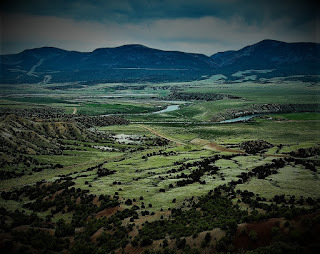
Way out in the far northeastern corners of Utah and northwestern Colorado, just south of the Wyoming border, a lonely valley stretches along the Green River: Brown’s Park, or Brown’s Hole if you prefer. Nowadays, it is a far piece from anywhere and not all that easy to get to. But it was a well-traveled place in the Old West.
For time out of mind, it was frequented by the Shoshoni, Ute, and Comanche. Blackfoot, Arapaho, Cheyenne, Lakota, and Navajo also visited. Fur trappers set up shop there in the 1830s, and Fort Davy Crockett opened up to supply and defend them in 1837. Ranchers followed the mountain men, wintering cattle there as well as establishing ranches.
One of those ranches spawned Ann and Josie Bassett, who collaborated with cattle rustlers, horse thieves, robbers, and other bandits who made Brown’s Hole an outpost on the Outlaw Trail that ran from Robber’s Roost to the south and Hole in the Wall to the north. Among the most renowned outlaws who hid out there were Butch Cassidy and his Wild Bunch and, later, the fugitive Tom Horn.
Despite an enduring desire to go there, I have yet to set foot in Brown’s Park. One of these days…
January 13, 2021
Rawhide Robinson gets a re-ride.
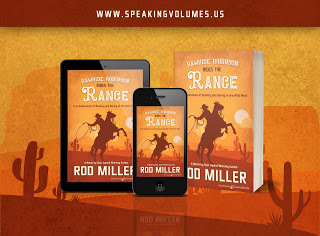 Some of you will be familiar with Rawhide Robinson. He’s the ordinary cowboy who spins stories about his extraordinary experiences. He’s the star of three award-winning novels,
Rawhide Robinson Rides the Range
,
Rawhide Robinson Rides the Tabby Trail
, and
Rawhide Robinson Rides a Dromedary
. His outlandish tales are enjoyable for readers from junior high age to geriatrics. He even has his own website where you can get to know him.
Some of you will be familiar with Rawhide Robinson. He’s the ordinary cowboy who spins stories about his extraordinary experiences. He’s the star of three award-winning novels,
Rawhide Robinson Rides the Range
,
Rawhide Robinson Rides the Tabby Trail
, and
Rawhide Robinson Rides a Dromedary
. His outlandish tales are enjoyable for readers from junior high age to geriatrics. He even has his own website where you can get to know him.The news of the day is that Rawhide Robinson is once again riding into the literary world, in new paperback and eBook editions from the publishing house Speaking Volumes.
Rawhide Robinson Rides the Range: True Adventures of Bravery and Daring in the Wild West is now available in paperback and eBook. That’s the handsome new cover above. The other two Rawhide Robinson novels previously published in hardcover will be along soon in paperback and eBook. And, somewhere down the trail, another Rawhide Robinson adventure will be available for the first time—Rawhide Robinson Rides a Wormhole: A True Tale of Bravery and Daring in the Weird West.
For gifts, for yourself, or just for fun, when Rawhide Robinson rides into your life you’ll have a lot to laugh about. Stand by for crass commercialism. Here’s where the new edition of Rawhide Robinson Rides the Range is now on sale:
Paperback:
Amazon US
Barnes & Noble
eBook:
Amazon US
Apple Books
Barnes & Noble
Google Play
Kobo Books
January 3, 2021
The Bird has flown.
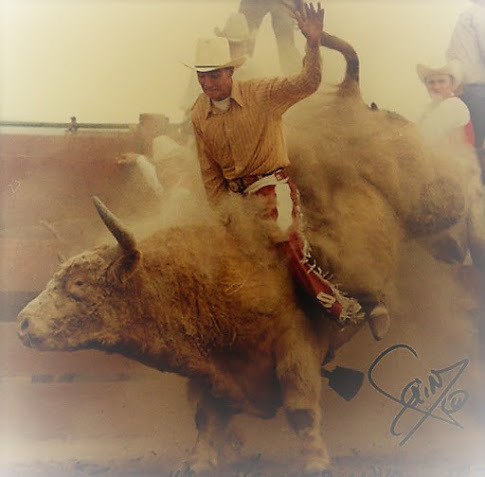
Back in our college days when all the rodeo bums who lived at or hung around the Rounder House were known by nicknames more than names, Marlowe Carroll was Bird, or the Bird Man, a moniker earned by long, skinny legs.
More than anyone else I can think of, Bird was influential in my rodeo years. When I arrived at USU he ran the Rodeo Club and was the star of the Intercollegiate Rodeo Team, winning a bunch in both bareback and bull riding. He made sure I was involved in the club, and encouraged and supported and assisted my efforts as I earned a place on the team, eight seconds at a time. We spent a lot of time together, much of it involved in activities best unmentioned—but those days resulted in a lifetime’s worth of memories.
A series of brain aneurisms and strokes while still a young man ended Marlowe’s rodeo career and landed him in a wheelchair, his agile mind betrayed by a mostly unresponsive body. Still, he lived for decades and never lost his sense of humor or happy outlook on life.
Marlowe—Bird—left this life in late December, and made the whistle with the same grit and try that you see on his face in the photo of him aboard the infamous bucking bull Fuzzy 4.
(The other fuzzy photo shows the USU Rodeo Club in 1971. That’s Marlowe in the upper right; yours truly is there on the left.)
WOMB TO TOMB
for Marlowe
Two hearts. One beats steady
and strong. The other races by.
Confinement presses knee
against rib, back to thigh.
Sounds, muffled and distant,
penetrate. Irresistible, the urge.
Pull. Squeeze. Slide. Every muscle
tense, you nod and emerge;
delivered into chaotic glare
assaulted by motion and sound.
Bull bellows. Brain blows.
Body, unbound, seeks ground.
Face down in arena dirt
consciousness goes astray
as flooding blood erodes neurons
and synapses wash away.
Tucked, then, into the coffin of
a body cold and unresponsive;
rolling through years gathering
dust as memories weave
tapestries of Rounders and rodeo,
broncs and bulls—of life before
a hemorrhagic stroke of bad luck
drew you out to ride no more.

